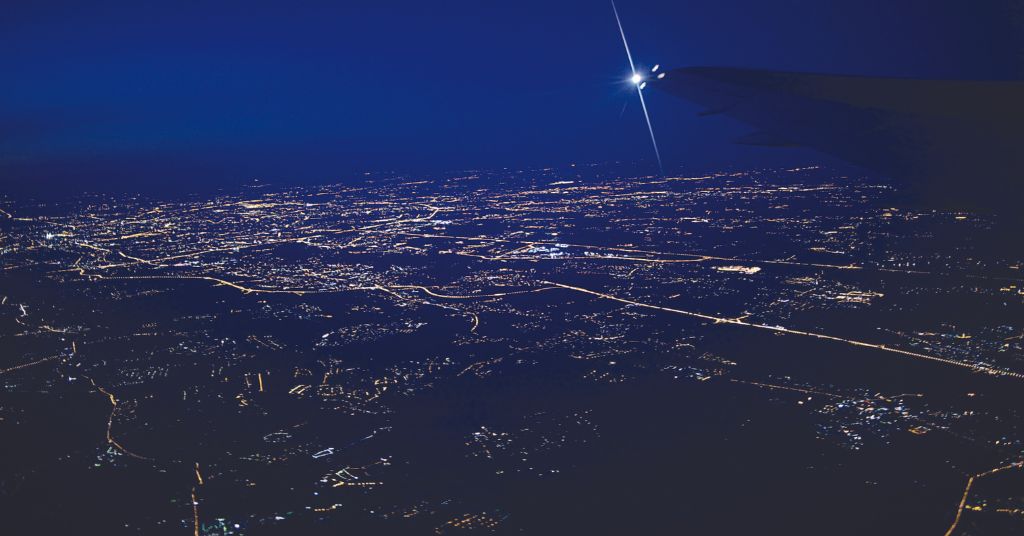Now that daylight savings time is over, night flying is much more in play. Even if you are not planning a night flight, unexpected delays can easily push a day flight into the night. While flying at night can be a very enjoyable experience, it requires a few additional preparations.
- A successful night flight always begins with detailed preflight planning. A few things that might be different from a planned daylight flight would begin with planning a route with landmarks that are easily visible at night. You should also complete a route log. At night, it is easy to focus on something you think is your selected landmark but is actually something else. By always knowing the headings and time to the next landmark, you are less likely to chase a landmark in the wrong direction. Also, be sure to pay attention to airport operating hours and whether you should use the tower frequency or the CTAF at your time of arrival.
- A thorough weather briefing is also imperative, with special attention to visibility and cloud layers. Low visibility, even if within VFR limits, should dictate an IFR-only flight. Low visibility can be very disorienting at night, especially with the effects of strobe lights and rotating beacons. Unless there is a bright moon, clouds are not always obvious at night. One minute, you can be in the clear with abundant ground lights on display, and the next, you have zero visibility. The same can be said about flying in a rural area or over water. Without ground lights, the horizon can be lost and disorientation can occur.
- It should go without saying that a thorough preflight is required, with special emphasis on aircraft lighting. Make sure to check the cockpit and instrument lights as well. Any inoperative lights need to be replaced before a night flight is attempted. If possible, the lights should be checked earlier in the day to allow time for replacement and to avoid the temptation to fly with a broken light.
- At least two different flashlights should be carried. There should be a bright light for the preflight and for checking the wings for any ice accumulation. This bright light should not be used for reading charts. The other light should be a much lower-powered flashlight for use in the cockpit. A light with a loop to hang around your neck that can produce either red or white light is very handy. If a light is not secured, it will inevitably disappear down the black hole on the floor. Carrying a third light with a broader beam is also a good idea to view the aircraft panel if an electrical failure occurs.
- It is important that you keep scanning the sky for traffic. It is not difficult to spot traffic above you, but be extra vigilant for traffic at or below your altitude, whose lights can easily disappear in the ground lights. By scanning left and right, your peripheral vision will more readily pick up the motion of other traffic.
- Airports can be difficult to find at night, especially when surrounded by higher-population areas. First, take note of the general location of the airport in relation to the city as a whole and then in relation to more easily recognizable landmarks, such as major highways. Once you know the general area, look for the rotating beacon. Be sure that the beacon location fits the proper geographical location you have determined. In a city with multiple airports and rotating beacons, it is not difficult to focus on the first one you see without making sure it fits the right geographical location.
- If you are flying into an airport with an operating control tower and are having difficulty locating the airport, even if the controller says it is at twelve o’clock and three miles, ask for the runway lights to be turned up. You will be able to see the lights brighten, and the airport will most likely be closer than where you are looking.
- If you are flying into an uncontrolled airport, you should check in advance to see if the airport has pilot-controlled lighting and the frequency to use. Uncontrolled airports often keep the lights low to reduce operating costs. By clicking your mic button several times, according to the information in the FAA Chart Supplement for that airport, you can make the lights brighter to help locate the airport. The lights will automatically dim after a preset amount of time, so you may need to activate them more than once.
Night flying can be a wonderful and enjoyable experience with the proper preparation. If you plan on carrying passengers, make sure you have had at least three night takeoffs and landings to a full stop in the last 90 days.










